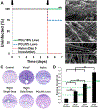Engineering biomaterials to prevent post-operative infection and fibrosis
- PMID: 33710589
- PMCID: PMC8238864
- DOI: 10.1007/s13346-021-00955-0
Engineering biomaterials to prevent post-operative infection and fibrosis
Abstract
Implantable biomaterials are essential surgical devices, extending and improving the quality of life of millions of people globally. Advances in materials science, manufacturing, and in our understanding of the biological response to medical device implantation over several decades have resulted in improved safety and functionality of biomaterials. However, post-operative infection and immune responses remain significant challenges that interfere with biomaterial functionality and host healing processes. The objectives of this review is to provide an overview of the biology of post-operative infection and the physiological response to implanted biomaterials and to discuss emerging strategies utilizing local drug delivery and surface modification to improve the long-term safety and efficacy of biomaterials.
Keywords: Bacterial adhesion; Biomaterials; Fibrosis; Infection; Inflammation; Surface modification; Sustained release.
Conflict of interest statement
Competing Interests:
K.S.P. and L.M.E. are inventors on patent applications related to electrospinning approaches for producing drug-eluting sutures. All other authors declare no conflict of interest.
Figures




References
-
- Wang X Overview on biocompatibilities of implantable biomaterials. Advances in Biomaterials Science and Biomedical Applications in Biomedicine; Lazinica R, Ed. 2013:111–55.
-
- Kang C-W, Fang F-Z. State of the art of bioimplants manufacturing: part II. Advances in Manufacturing. 2018;6(2):137–54.
-
- Gristina AG. Biomaterial-centered infection: microbial adhesion versus tissue integration. Science. 1987;237(4822):1588–95. - PubMed
-
- Berríos-Torres SI, Umscheid CA, Bratzler DW, Leas B, Stone EC, Kelz RR, et al. Centers for disease control and prevention guideline for the prevention of surgical site infection, 2017. JAMA surgery. 2017;152(8):784–91. - PubMed
-
- Schierholz J, Beuth J. Implant infections: a haven for opportunistic bacteria. Journal of Hospital Infection. 2001;49(2):87–93. - PubMed
Publication types
MeSH terms
Substances
Grants and funding
LinkOut - more resources
Full Text Sources
Other Literature Sources

